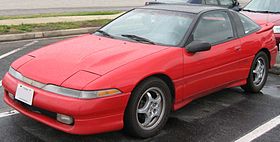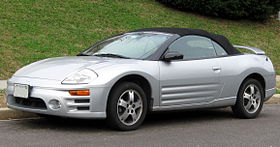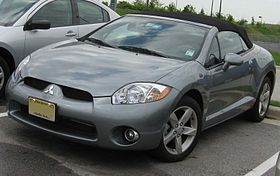Mitsubishi Eclipse
Mitsubishi Eclipse 
Overview Manufacturer Mitsubishi Motors
Diamond-Star Motors Production 1989–2011[1] Model years 1990-2012 Assembly Normal, Illinois, United States Body and chassis Class Sport Compact Body style 2-door liftback coupe
2-door convertible Chronology Predecessor Mitsubishi Cordia Successor None
The Mitsubishi Eclipse is a sport compact car produced by Mitsubishi between 1989 and 2011. A convertible body style was added during the 1996 model year. The Eclipse was named after an unbeaten 18th-century English racehorse which won 26 races,[2] and has also been rebadged and sold as the Eagle Talon and the Plymouth Lasercaptive imports through Mitsubishi Motors' close relationship with the Chrysler Corporation. Their partnership was known as Diamond-Star Motors, or DSM, and the vehicle trio through the close of the second-generation line is sometimes referred to by the moniker "DSM" among enthusiast circles. In Japan, the first two generations were sold at a specific Japanese retail chain called Mitsubishi Car Plaza.
The Eclipse was officially marketed in North America, Oman, South Korea, the Philippines, Brazil, Saudi Arabia,Kuwait, UAE, and China. At the end of August 2011, the final Eclipse rolled off the assembly line, and was auctioned off, the proceeds donated to charity.[3] It was not related to the Mitsubishi FTO while having a similar marketing approach.
The Eclipse has undergone four distinct generations: the first two generations (1G and 2G) share the automobile platform and parts with the Eagle Talon, and the Plymouth Laser, while the third generation (3G) shared a redesigned platform with the Chrysler Sebring and Dodge Stratus. During May 2005, the fourth, and final, generation (4G) Eclipse was introduced, abandoning the Chrysler platform used in the first three generations and replacing it with the PS platform.[4]
| Mitsubishi Eclipse | |
|---|---|
 | |
| Overview | |
| Manufacturer | Mitsubishi Motors Diamond-Star Motors |
| Production | 1989–2011[1] |
| Model years | 1990-2012 |
| Assembly | Normal, Illinois, United States |
| Body and chassis | |
| Class | Sport Compact |
| Body style | 2-door liftback coupe 2-door convertible |
| Chronology | |
| Predecessor | Mitsubishi Cordia |
| Successor | None |
The Mitsubishi Eclipse is a sport compact car produced by Mitsubishi between 1989 and 2011. A convertible body style was added during the 1996 model year. The Eclipse was named after an unbeaten 18th-century English racehorse which won 26 races,[2] and has also been rebadged and sold as the Eagle Talon and the Plymouth Lasercaptive imports through Mitsubishi Motors' close relationship with the Chrysler Corporation. Their partnership was known as Diamond-Star Motors, or DSM, and the vehicle trio through the close of the second-generation line is sometimes referred to by the moniker "DSM" among enthusiast circles. In Japan, the first two generations were sold at a specific Japanese retail chain called Mitsubishi Car Plaza.
The Eclipse was officially marketed in North America, Oman, South Korea, the Philippines, Brazil, Saudi Arabia,Kuwait, UAE, and China. At the end of August 2011, the final Eclipse rolled off the assembly line, and was auctioned off, the proceeds donated to charity.[3] It was not related to the Mitsubishi FTO while having a similar marketing approach.
The Eclipse has undergone four distinct generations: the first two generations (1G and 2G) share the automobile platform and parts with the Eagle Talon, and the Plymouth Laser, while the third generation (3G) shared a redesigned platform with the Chrysler Sebring and Dodge Stratus. During May 2005, the fourth, and final, generation (4G) Eclipse was introduced, abandoning the Chrysler platform used in the first three generations and replacing it with the PS platform.[4]
First Generation (1G) (1990–1994)
First generation 
Overview Also called DSM, 1G Production 1989–1994 Model years 1990-1994 Body and chassis Class Sport Compact Body style 2-door coupé Layout Front-engine, front-/all-wheel drive Platform Chrysler D platform Related Mitsubishi Galant
Eagle Talon
Plymouth Laser Powertrain Engine 1.8 L 92 hp (69 kW) I4
2.0 L 135 hp (101 kW) I4
2.0 L 180 hp (130 kW) I4 turbo
2.0 L 195 hp (145 kW) I4 turbo Transmission 5-speed manual
4-speed automatic Dimensions Wheelbase 2,470 mm (97.2 in) Length 4,390 mm (172.8 in) Width 1,690 mm (66.7 in) Height 1,310 mm (51.4 in)
GSX: 1,300 mm (52 in) Curb weight Base: 1,145 kg (2,524 lb)
FWD turbo:1,245 kg (2,745 lb)
AWD turbo: 1,404 kg (3,095 lb)

Eagle Talon
Plymouth Laser
2.0 L 135 hp (101 kW) I4
2.0 L 180 hp (130 kW) I4 turbo
2.0 L 195 hp (145 kW) I4 turbo
4-speed automatic
GSX: 1,300 mm (52 in)
FWD turbo:1,245 kg (2,745 lb)
AWD turbo: 1,404 kg (3,095 lb)
Overview
The first generation Mitsubishi Eclipse was marketed as an entry to mid-level four-cylinder sports coupe. Four trim levels were available: the lowest three were front-wheel drive and the highest was all-wheel drive. The top FWD and the AWD model were equipped with turbocharged engines.
The first generation Eclipse underwent minor styling changes throughout its production; 1992–1994 models have updated sheetmetal and are easily distinguishable from earlier model years. The most notable of these changes is that the 1990-1991 models have pop-up headlights, whereas the later model years do not. The Eclipse was revised for the 1995 model year as the second generation.
The Plymouth Laser model was dropped after the 1994 model year, leaving only the Eclipse and Talon to continue for the second generation.
Second Generation (2G) (1995–1999)
| Second generation | |
|---|---|
 | |
| Overview | |
| Also called | DSM, 2G |
| Production | 1995–1999 |
| Body and chassis | |
| Class | Sport Compact |
| Body style | 2-door convertible 2-door coupé |
| Layout | Front-engine, front-/all-wheel drive |
| Platform | Chrysler PJ platform |
| Related | Eagle Talon Mitsubishi Galant |
| Powertrain | |
| Engine | 2.0 L 140 hp (100 kW) I4 2.4 L 141 hp (105 kW) I4 2.0 L 210 hp (160 kW) turbo I4 |
| Transmission | 4-speed automatic 5-speed manual |
| Dimensions | |
| Wheelbase | 2,510 mm (98.8 in) |
| Length | 1995-96: 4,370 mm (172.2 in) 4,380 mm (172.4 in) |
| Width | 1,740 mm (68.7 in) |
| Height | 1995-96: 1,280 mm (50.2 in) Convertibles: 1,340 mm (52.8 in) GSX: 1,280 mm (50.5 in) 1997-99: 1,260 mm (49.8 in) |
| Curb weight | FWD non-turbo coupe: 1,235 kg (2,723 lb) FWD turbo coupe:1,305 kg (2,877 lb) AWD turbo coupe:1,460 kg (3,210 lb) Convertible: 1,310 kg (2,888 lb) |
Overview
The second generation car maintained the market focus of the first generation car, but had a major redesign and was fitted with different engines between trim levels. A convertible model, named the Spyder was introduced in 1996. The Spyder was available in two trims; the GS and the GS-T. The Spyder GS model was powered by a 2.4L I-4 non-turbo 4G64 engine. The Spyder GS-T was fitted with Mitsubishi's turbocharged 4G63 engine. The GSX model was also powered by this engine but with the addition of a high performance all wheel drive system. No convertible model was powered by the Chrysler's 420a engine, nor was there a convertible with all-wheel-drive.
The turbocharged engine option continued as the 4G63. It was also updated for more power as compared to the previous generation (210 hp vs 195 hp). The non-turbo equipped car had two different I-4 engines depending on the market they were produced for. The US version engines were producing 140 hp, found only in the hardtop RS and GS trims, was a modified version of the Chrysler Neon engine, the 420a, manufactured by Chrysler and delivered to and installed at the Diamond Star Motors facility. The European market engines were naturally aspirated 4G63 with 141 hp (105 kW; 143 PS).
The Talon was discontinued in 1998, along with the rest of the Eagle line, leaving only the Eclipse for sale during the 1999 model year.
As the width dimension and larger engines were offered to Japanese consumers, it was now regarded as a luxury car, as this generation no longer complied with Japanese Government dimension regulations, and Japanese consumers were liable for annual taxes as a result, which affected sales.
A special version of the Eclipse, called the "10th Anniversary OZ Rally", was sold at the end of the 1999 model run with unique 16-inch Enkei wheels with the OZ Racing logo. It also included the leather interior package, accented exhaust exit, and hoop-style spoiler that were available as standard equipment on GS-T and GSX models. The special edition package was only offered with the 420A engine.
Third Generation (3G) (2000–2005)
Third generation 
Overview Production 1999–2005 Model years 2000-2005 Body and chassis Body style 2-door convertible
2-door coupe Layout FF layout Platform Chrysler ST-22 platform Related Mitsubishi Galant
Chrysler Sebring coupe
Dodge Stratus coupe Powertrain Engine 2.4 L 150 hp (110 kW) I4
2.4 L 150 hp (110 kW) I4
3.0 L 200 hp (150 kW) V6
3.0 L 210 hp (160 kW) V6 Transmission 4-speed automatic
5-speed manual Dimensions Wheelbase 2,560 mm (100.8 in) Length 2004-05: 4,491 mm (176.8 in)
2000-03: 4,455 mm (175.4 in) Width 1,750 mm (68.9 in) Height 2001-05 Coupe: 1,311 mm (51.6 in)
Spyder: 1,341 mm (52.8 in)
2000: 1,316 mm (51.8 in) Curb weight 2.4 coupe: 1,280 kg (2,822 lb)
2.4 convertible: 1,380 kg (3,042 lb)
V6 coupe: 1,385 kg (3,053 lb)
V6 convertible: 1,470 kg (3,241 lb)

2-door coupe
Chrysler Sebring coupe
Dodge Stratus coupe
2.4 L 150 hp (110 kW) I4
3.0 L 200 hp (150 kW) V6
3.0 L 210 hp (160 kW) V6
5-speed manual
2000-03: 4,455 mm (175.4 in)
Spyder: 1,341 mm (52.8 in)
2000: 1,316 mm (51.8 in)
2.4 convertible: 1,380 kg (3,042 lb)
V6 coupe: 1,385 kg (3,053 lb)
V6 convertible: 1,470 kg (3,241 lb)
Overview
The Eclipse underwent a change into its third generation in 1999, closely applying the Mitsubishi SST design study which debuted at the 1998 North American International Auto Show. It was the first concept vehicle exhibited by Mitsubishi at an auto show in the U.S.[11]
Two new powertrain options were available, a 147 hp 2.4 L 16-valve SOHC 4-cylinder 4G64 and a 205 hp 24v SOHC 3.0 L V6 (6G72). AWD was no longer an option. The suspension setup was adjusted to provide a softer and more compliant ride quality.
The third generation Eclipse shared its powertrain with the 8th generation Galant. In late 2001, power of the GT trim was lowered to 200 hp (150 kW) as a result of tightened emission standards forcing MMNA to adopt the Californiaemissions standards for all variants of the car, rather than selling independent 'Fed Spec' and 'Cali Spec' versions.
In mid-2002, the GTS trim was introduced for the 2003 model year. This vehicle included an engine with a 10:1 compression ratio, revised camshaft profile and an improved Mitsubishi Variable Induction Management (MVIM) air intake system that gave the car an extra 10 hp (7.5 kW) and a slightly improved power curve. The 2003–2005 GTS coupe, GTS Spyder and GT Spyder[12] shared the new engine while the GT coupe retained the 200 hp (150 kW) powertrain.
Fourth Generation (4G) (2006–2012)
| Fourth generation | |
|---|---|
 | |
| Overview | |
| Production | 2005-2011 |
| Model years | 2006-2012 |
| Body and chassis | |
| Body style | 2-door convertible 2-door coupe |
| Layout | FF layout |
| Platform | Mitsubishi PS platform |
| Related | Mitsubishi Endeavor Mitsubishi Galant |
| Powertrain | |
| Engine | 2.4 L 162 hp (121 kW) I4 3.8 L 263 hp (196 kW) V6 |
| Transmission | 4-speed automatic 5-speed automatic 5-speed manual 6-speed manual |
| Dimensions | |
| Wheelbase | 2,576 mm (101.4 in) |
| Length | 2006-08: 4,564 mm (179.7 in) 2009-2011: 4,583 mm (180.4 in) |
| Width | 1,834 mm (72.2 in) |
| Height | 2006-2010: 1,359 mm (53.5 in) 2006–2010 Spyder: 1,382 mm (54.4 in) 2006–2010 GT Spyder: 1,389 mm (54.7 in) 2011: 1,351 mm (53.2 in) 2011 Spyder: 1,375 mm (54.1 in) |
| Curb weight | 2.4 coupe 1,485 kg (3,274 lb) V6 coupe 1,575 kg (3,472 lb) 2.4 convertible 1,575 kg (3,472 lb) V6 convertible 1,665 kg (3,671 lb) |
Overview
Another substantial styling revision was introduced, with the new model taking some of the profile from the second generation model but maintaining a front fascia consistent with Mitsubishi's current corporate styling features. Drivetrain features of the new model include a 263 hp (196 kW) 3.8 L MIVEC V6 for the GT trim, 2009 and newer models have 265 hp. The GS has a 162 hp (121 kW) 2.4 L MIVEC four-cylinder, both derived from the Mitsubishi PS platform family, with which the Eclipse shares many mechanical components. Like the 2004 Galant and third generation Eclipse, the new Eclipse is FWD only, although a concept model has been produced by Mitsubishi and Ralliart with a MillenWorks designed hybrid-electric AWD platform, the 4G63 engine from the Lancer Evolution, and more aggressive body styling with imitation carbon fiber accents.[14] The V6 produces 263 hp (196 kW) and 260 ft·lbf (350 N·m) of torque.
The fourth-generation Spyder (convertible) Eclipse was released for the 2007 model year at the North American International Auto Show.
Trim levels
For the 2010 model year in the U.S., its primary market, the Eclipse was available in five trim levels: GS, GS Sport Spyder, GS Sport, GT, and GT Spyder. In Mexico, the GT Spyder is known as the Eclipse Convertible. In Canada, the GT trim is known as the GT-P.
- Eclipse GS: Base FWD model equipped with a 162 hp (121 kW) 2.4 L 16-valve SOHC Mitsubishi 4G69 engine
- Eclipse GS Sport Spyder: Convertible FWD model equipped with a 162 hp (121 kW) 2.4 L 16-valve SOHC Mitsubishi 4G69 engine
- Eclipse GS Sport: FWD model equipped with a 162 hp (121 kW) 2.4 L 16-valve 4-cylinder MIVEC Engine, and additional features.
- Eclipse GT: Hardtop FWD model equipped with a 263 hp 3.8 L 24-valve SOHC Mitsubishi 6G75 engine, 2009–2012 models have 265 hp
- Eclipse GT Spyder: Convertible FWD model equipped with a 263 hp 3.8 L 24-valve SOHC Mitsubishi 6G75 engine, 2009–present models have 265 hp
The models and standard / optional equipment:
- GS Standard- Choice of five-speed manual or a four-speed Sportronic automatic transmission, a 140-watt(max.) Mitsubishi CD/MP3-compatible audio system with six speakers, 17-inch alloy wheels, an anti-theft immobilizer, auto-off halogen headlamps, power windows/locks/mirrors, air conditioning, a split fold-down rear seat, two 12-volt accessory outlets, anti-lock brakes, a rear spoiler, and a six airbag safety system.
Options Include - Sun & Sound package with a power sunroof is paired with a 650-watt (max.) Rockford Fosgate audio system. Boasting nine speakers including a 10-inch (250 mm) trunk-mounted subwoofer, a 6-CD in-dash changer, and steering wheel-mounted audio controls, the package also includes a center display with outside temperature and compass readings and an electrochromic rear-view mirror. A four piece body kit comes as an optional "aero kit" package for all models.
- GS Spyder - available for sale for the 2007 model year.
Options Include - GS Deluxe Leather Package: Leather front seating surfaces. Heated front seats. Heated side mirrors. Outside temperature indicator and compass in center dash display.
- GT Standard- Choice of six-speed manual or a five-speed Sportronic automatic transmission, a 140-watt (max.) Mitsubishi CD/MP3-compatible audio system with six speakers, 17-inch alloy wheels, an anti-theft immobilizer, auto-off halogen headlamps, fog lamps, power windows/locks/mirrors, air-conditioning, a split fold-down rear seat, two 12-volt accessory outlets, 4-wheel anti-lock disc brakes, a rear spoiler, dual-stage six airbag safety system, traction control, a front strut tower bar, and a center display with outside temperature and compass readings.
Options Include- Premium Sport Package with 18 in (460 mm) seven-spoke alloy wheels, leather front seating surfaces, a power sunroof, an eight-way-adjustable (six power) driver's seat, alloy pedals, heated front seats, heated door mirrors, automatic dimming rear-view mirror, air-conditioning and a 650-watt (max.) Rockford Fosgate audio system with nine speakers, including a 10-in (254 mm) trunk-mounted subwoofer, a 6-CD/MP3-compatible in-dash changer, steering wheel-mounted audio controls.
- GT Spyder - available for sale for the 2007 model year.
Options Include - GT Premium Sport Package: 18-inch Alloy wheels. Leather front seating surfaces. 6-way power driver's seat. Heated front seats. Heated side mirrors. Aluminum pedals. Automatic climate control. Wind Deflector




No comments:
Post a Comment